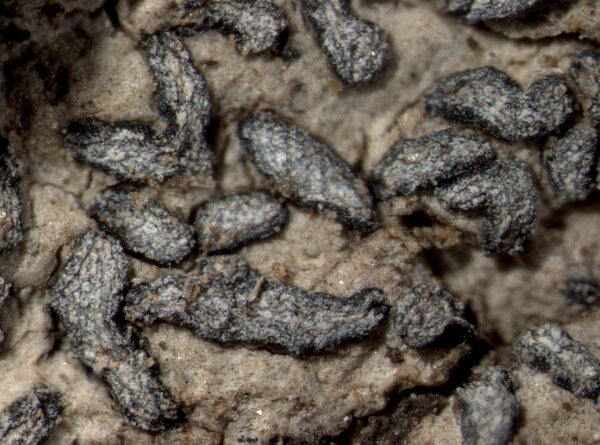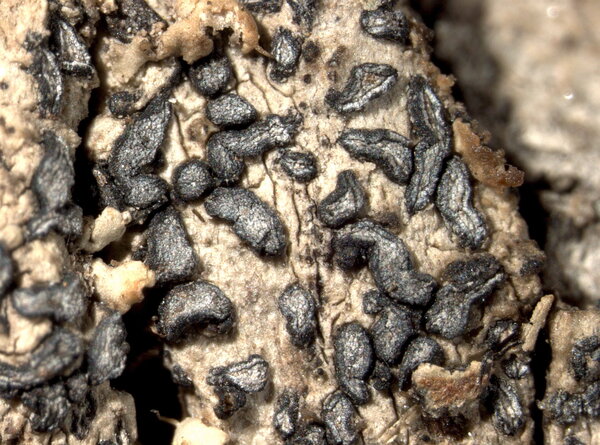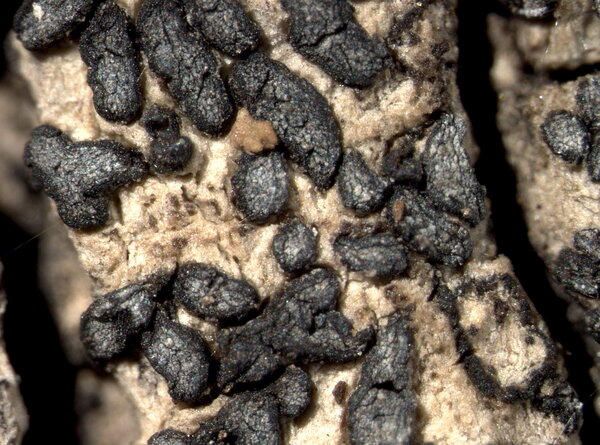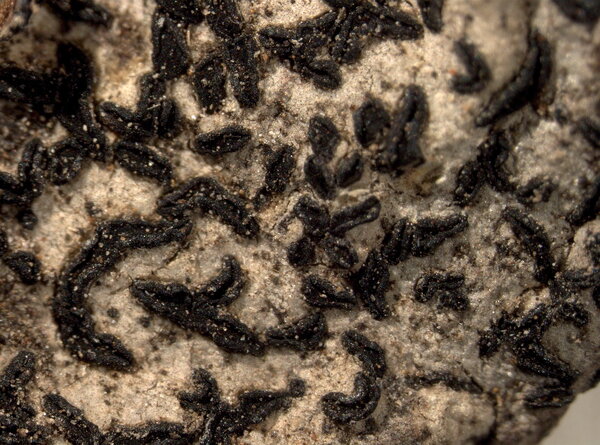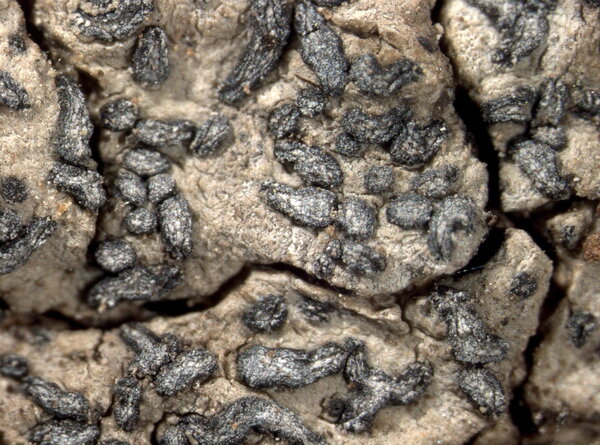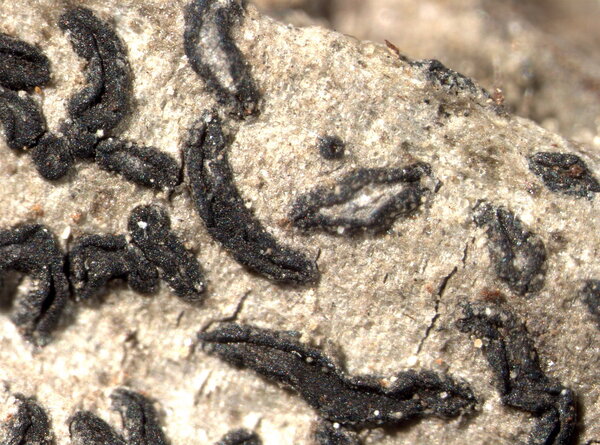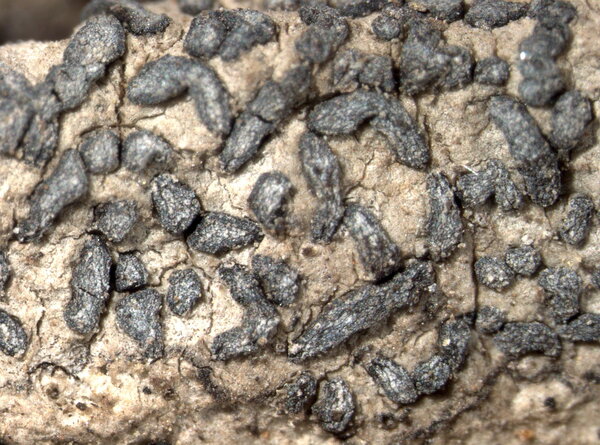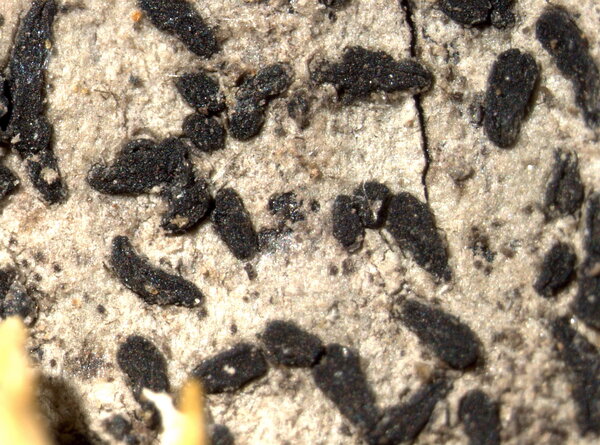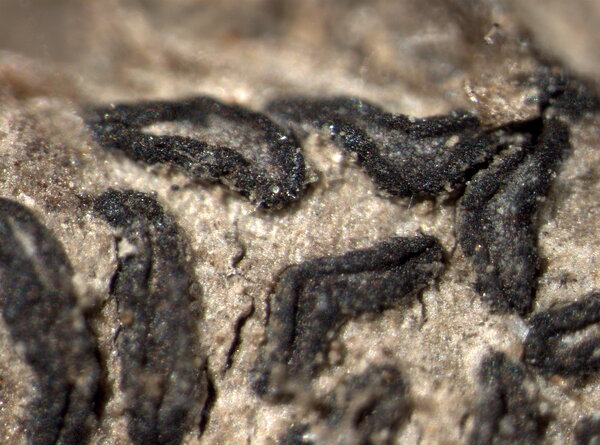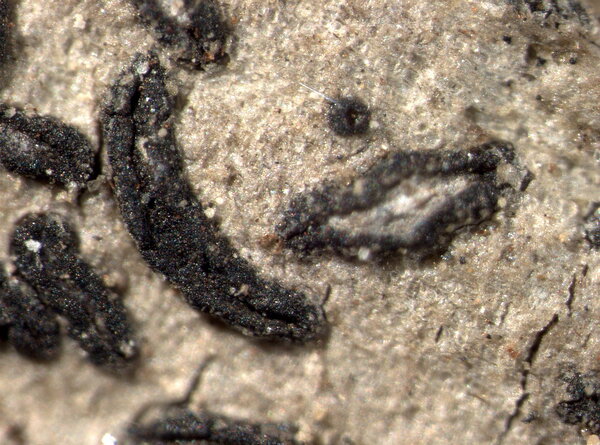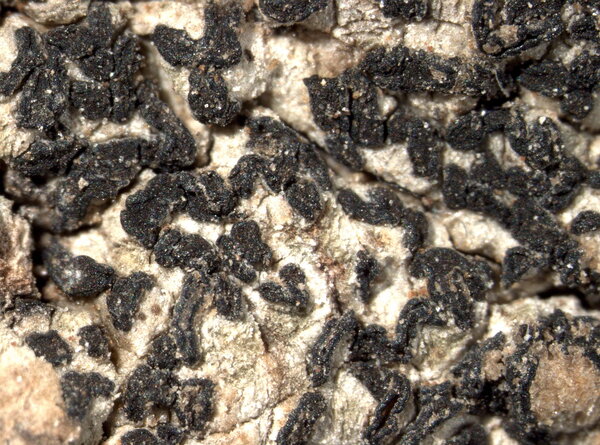Opegrapha celtidicola (Jatta) Jatta
N. Giorn. Bot. Ital., 12: 231, 1880. Basionym: Lecanactis lyncea var. celtidicola Jatta - N. Giorn. Bot. Ital., 7: 229, 1875.
Synonyms: Opegrapha betulinoides B. de Lesd.; Opegrapha thallincola B. de Lesd.; Opegrapha xylographoides J. Steiner
Distribution: N - Piem (Giordani & Malaspina 2016), Lig (Watson 2014). C - Tosc (Loppi & al. 1997c, 1999a), Marc (Nimis & Tretiach 1999), Laz (Stofer 2006). S - Camp (Aprile & al. 2002, 2003b), Pugl (Nimis & Tretiach 1999, Durini & Medagli 2002, Brackel 2011), Bas (Bartoli & Puntillo 1998, Nimis & Tretiach 1999, Potenza & al. 2010), Cal (Puntillo 1996, Incerti & Nimis 2006), Si (Grillo & al. 2007).
Description: Thallus crustose, thinly episubstratic, white to whitish grey, without a distinct prothallus. Apothecia lirelliform, black, polygonal, elliptical or elongated, usually simple, 0.5-2 x 0.4-0.8 mm, usually numerous, scattered or clustered, with a more or less expanded, often white-pruinose disc and a thick, epruinose, raised proper margin. Proper exciple black, carbonized, not extending below the hymenium; epithecium brownish, 20-35 µm high; hymenium colourless, 70-100 µm high, I+ blue; paraphysoids branched and anastomosing, 1-1.5 µm thick, the apical cells hardly swollen; hypothecium colourless or pale yellow. Asci 8-spored, broadly club-shaped, the inner layer of endoascus amyloid in upper part, with a reduced ring and ocular chamber (Varia-type). Ascospores (2-)3(-4)-septate, slightly constricted at septa, hyaline, often becoming brownish when overmature, ellipsoid, 13-20 x 3-6 µm, with a thin gelatinous perispore. Pycnidia black, immersed. Conidia simple, straight or slightly curved, 4-6 x c. 1 µm. Photobiont trentepohlioid. Spot tests: thallus K- or K+ pale yellow, C-, KC-, P-. Chemistry: without lichen substances.Note: a Mediterranean-Atlantic lichen found on old trees, near the base of the trunks, but also on twigs of Mediterranean shrubs, at relatively low elevations; mainly Tyrrhenian in Italy. The species often overgrows the thalli of other lichens with Trentepohlia (Schismatomma, Dirina ceratoniae, etc.).
Growth form: Crustose
Substrata: bark
Photobiont: Trentepohlia
Reproductive strategy: mainly sexual
Most common in areas with a humid-warm climate (e.g. most of Tyrrenian Italy)
Commonnes-rarity: (info)
Alpine belt: absent
Subalpine belt: absent
Oromediterranean belt: absent
Montane belt: absent
Submediterranean belt: extremely rare
Padanian area: absent
Humid submediterranean belt: rare
Humid mediterranean belt: rather rare
Dry mediterranean belt: absent
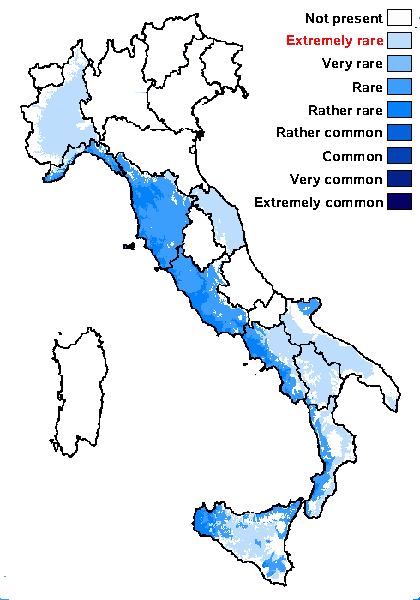
Predictive model
Herbarium samples
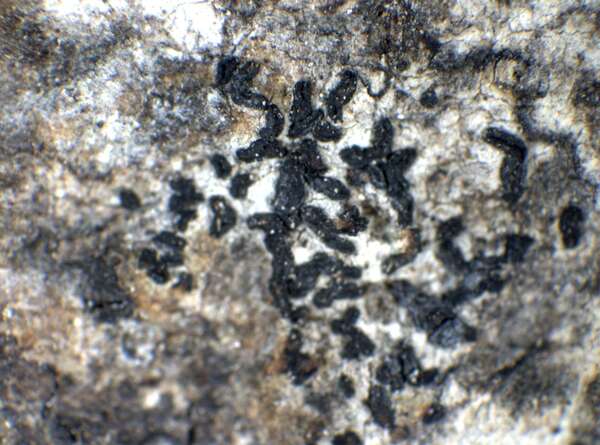

P.L. Nimis; Owner: Department of Life Sciences, University of Trieste
Portugal.
Herbarium: TSB (11874)
2001/11/27
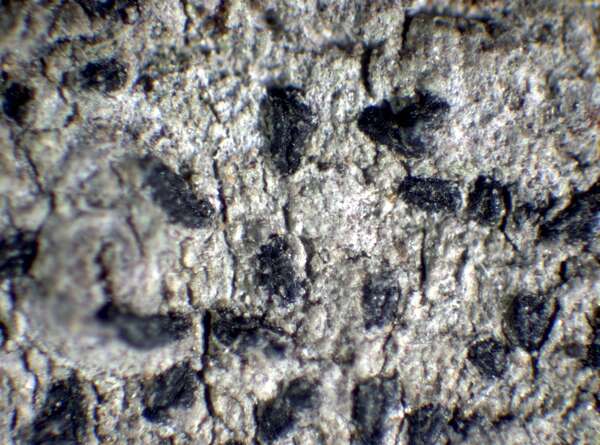

P.L. Nimis; Owner: Department of Life Sciences, University of Trieste
Herbarium: TSB (23096)
2001/11/27
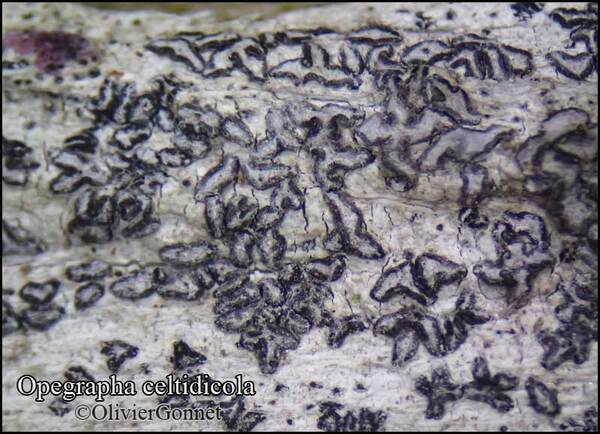
Courtesy Danièle et Olivier Gonnet - Source: https://www.afl-lichenologie.fr/Photos_AFL/Photos_AFL_O/Texte_O/Opegrapha_celtidicola.htm
France, 22/5/2014 - sur écorce de Cupressus, ouvrage du Libron - Hérault

Courtesy Danièle et Olivier Gonnet - Source: https://www.afl-lichenologie.fr/Photos_AFL/Photos_AFL_O/Texte_O/Opegrapha_celtidicola.htm
France, 22/5/2014 - sur écorce de Cupressus, ouvrage du Libron - Hérault
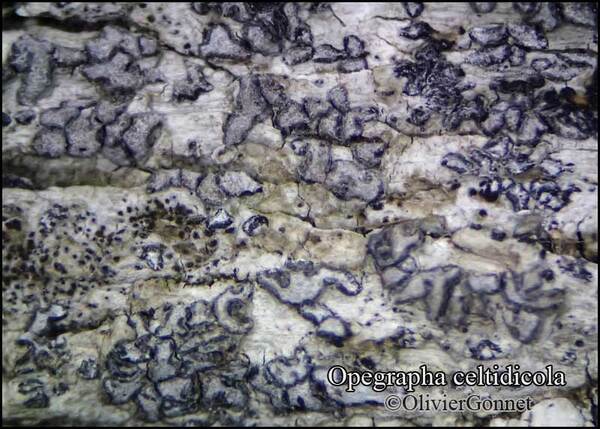
Courtesy Danièle et Olivier Gonnet - Source: https://www.afl-lichenologie.fr/Photos_AFL/Photos_AFL_O/Texte_O/Opegrapha_celtidicola.htm
France, 22/5/2014 - sur écorce de Cupressus, ouvrage du Libron - Hérault
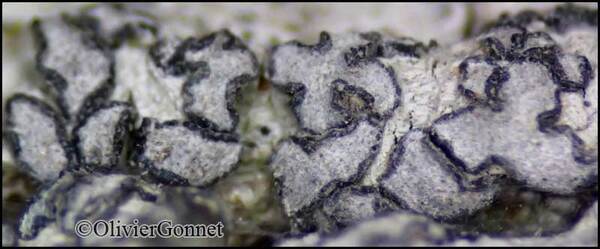
Courtesy Danièle et Olivier Gonnet - Source: https://www.afl-lichenologie.fr/Photos_AFL/Photos_AFL_O/Texte_O/Opegrapha_celtidicola.htm
France, 22/5/2014 - sur écorce de Cupressus, ouvrage du Libron - Hérault
Growth form: Crustose
Substrata: bark
Photobiont: Trentepohlia
Reproductive strategy: mainly sexual
Most common in areas with a humid-warm climate (e.g. most of Tyrrenian Italy)
Commonnes-rarity: (info)
Alpine belt: absent
Subalpine belt: absent
Oromediterranean belt: absent
Montane belt: absent
Submediterranean belt: extremely rare
Padanian area: absent
Humid submediterranean belt: rare
Humid mediterranean belt: rather rare
Dry mediterranean belt: absent

Predictive model
| Herbarium samples |


P.L. Nimis; Owner: Department of Life Sciences, University of Trieste
Portugal.
Herbarium: TSB (11874)
2001/11/27


P.L. Nimis; Owner: Department of Life Sciences, University of Trieste
Herbarium: TSB (23096)
2001/11/27

Courtesy Danièle et Olivier Gonnet - Source: https://www.afl-lichenologie.fr/Photos_AFL/Photos_AFL_O/Texte_O/Opegrapha_celtidicola.htm
France, 22/5/2014 - sur écorce de Cupressus, ouvrage du Libron - Hérault

Courtesy Danièle et Olivier Gonnet - Source: https://www.afl-lichenologie.fr/Photos_AFL/Photos_AFL_O/Texte_O/Opegrapha_celtidicola.htm
France, 22/5/2014 - sur écorce de Cupressus, ouvrage du Libron - Hérault

Courtesy Danièle et Olivier Gonnet - Source: https://www.afl-lichenologie.fr/Photos_AFL/Photos_AFL_O/Texte_O/Opegrapha_celtidicola.htm
France, 22/5/2014 - sur écorce de Cupressus, ouvrage du Libron - Hérault

 INDEX FUNGORUM
INDEX FUNGORUM
 GBIF
GBIF
